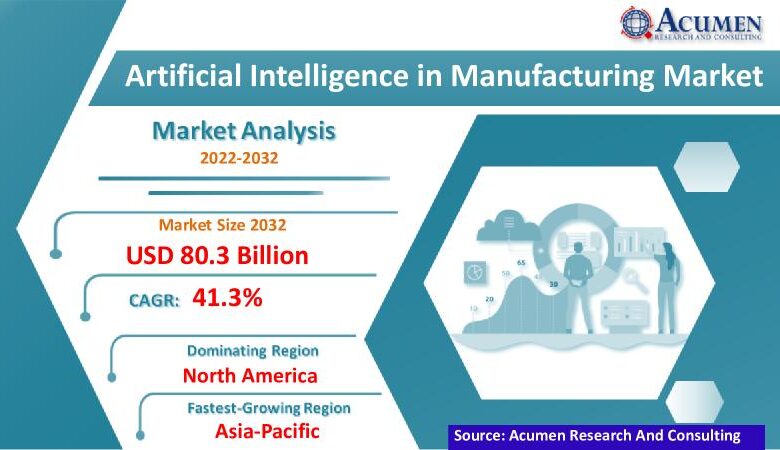Artificial Intelligence in Manufacturing Market Size to Worth

The Artificial Intelligence (AI) in manufacturing market has witnessed exponential growth in recent years, signaling a transformative shift in the industry. Valued at USD 3.7 billion in 2023, this market is poised to achieve a staggering size of USD 80.3 billion by 2032, growing at a compound annual growth rate (CAGR) of 41.3% from 2024 to 2032. This article delves into the competitive landscape, future growth prospects, opportunities, drivers, constraints, major market players, current trends, and regional insights.
Download Free Artificial Intelligence in Manufacturing Market Sample Report Here: (Including Full TOC, List of Tables & Figures, Chart) https://www.acumenresearchandconsulting.com/request-sample/3001
Competitive Landscape
The competitive landscape of AI in manufacturing is marked by intense rivalry among established technology giants and innovative startups. Companies like Siemens, IBM, and General Electric are leading the charge with substantial investments in AI research and development. Emerging players, such as UiPath and Automation Anywhere, are also making significant inroads by offering specialized AI solutions tailored to the manufacturing sector.
Future Growth Prospects
The future growth prospects of AI in manufacturing are promising. The market’s rapid expansion is driven by the increasing adoption of Industry 4.0 practices, which emphasize automation, data exchange, and real-time analytics. The integration of AI with Internet of Things (IoT) devices is expected to further enhance operational efficiency, predictive maintenance, and supply chain optimization.
Opportunities
Enhanced Productivity: AI-driven automation can significantly improve production efficiency by minimizing human error and reducing downtime.
Predictive Maintenance: AI algorithms can predict equipment failures before they occur, allowing for timely maintenance and reducing costly unplanned outages.
Supply Chain Optimization: AI can analyze vast amounts of data to optimize supply chains, leading to cost savings and improved delivery times.
Quality Control: AI-powered vision systems can detect defects with higher accuracy than human inspectors, ensuring higher product quality.
Energy Management: AI can optimize energy consumption in manufacturing processes, leading to substantial cost savings and reduced environmental impact.
Drivers
Several key drivers are propelling the growth of AI in the manufacturing sector:
Technological Advancements: Rapid advancements in machine learning, deep learning, and neural networks are enabling more sophisticated AI applications.
Data Availability: The proliferation of IoT devices and sensors is generating vast amounts of data that AI can analyze to derive actionable insights.
Cost Reduction: AI solutions are becoming more affordable, making them accessible to a broader range of manufacturers.
Government Initiatives: Governments worldwide are promoting smart manufacturing and Industry 4.0 through various initiatives and funding programs.
Constraints
Despite the promising outlook, several constraints could impede market growth:
High Initial Investment: Implementing AI solutions requires significant upfront investment in technology and infrastructure.
Skill Gap: There is a shortage of skilled professionals who can develop and manage AI applications in manufacturing.
Data Privacy and Security: The increasing reliance on data raises concerns about data privacy and security, which need to be addressed to gain the trust of manufacturers.
Integration Challenges: Integrating AI systems with existing manufacturing processes and legacy systems can be complex and time-consuming.
Current Market Trends
Several trends are currently shaping the AI in manufacturing market:
Adoption of AI-Powered Robotics: Manufacturers are increasingly using AI-powered robots for tasks ranging from assembly to packaging, enhancing precision and efficiency.
AI-Driven Digital Twins: Digital twins-virtual replicas of physical assets-are being used to simulate and optimize manufacturing processes in real-time.
Augmented Reality (AR) and Virtual Reality (VR): AR and VR technologies, combined with AI, are being used for training, maintenance, and quality assurance in manufacturing.
Edge Computing: The deployment of AI at the edge, closer to the data source, is gaining traction to reduce latency and improve real-time decision-making.
Table Of Content:
CHAPTER 1. Industry Overview of Artificial Intelligence in Manufacturing Market
CHAPTER 2. Research Approach
CHAPTER 3. Market Dynamics And Competition Analysis
CHAPTER 4. Manufacturing Plant Analysis
CHAPTER 5. Artificial Intelligence in Manufacturing Market By Offering
CHAPTER 6. Artificial Intelligence in Manufacturing Market By Technology
CHAPTER 7. Artificial Intelligence in Manufacturing Market By Application
CHAPTER 8. Artificial Intelligence in Manufacturing Market By Industry Vertical
CHAPTER 9. North America Artificial Intelligence in Manufacturing Market By Country
CHAPTER 10. Europe Artificial Intelligence in Manufacturing Market By Country
CHAPTER 11. Asia Pacific Artificial Intelligence in Manufacturing Market By Country
CHAPTER 12. Latin America Artificial Intelligence in Manufacturing Market By Country
CHAPTER 13. Middle East & Africa Artificial Intelligence in Manufacturing Market By Country
CHAPTER 14. Player Analysis Of Artificial Intelligence in Manufacturing Market
CHAPTER 15. Company Profile
Artificial Intelligence in Manufacturing Market Segmentation:
The worldwide market for AI in manufacturing is split based on component, type, power output, application, and geography.
AI in Manufacturing Offering
Hardware
Software
Services
AI in Manufacturing Technology
Machine Learning
Natural Language Processing
Computer Vision
Context-Aware Computing
AI in Manufacturing Application
Field Services
Quality Control
Material Movement
Predictive Maintenance and Machinery Inspection
Production Planning
AI in Manufacturing Industry Vertical
Automotive
Semiconductor & Electronics
Pharmaceutical
Heavy Metals & Machine Manufacturing
Food & Beverage
Energy & Power
Others
Regional Insights
The AI in manufacturing market is witnessing varied growth patterns across different regions:
North America: The region is at the forefront of AI adoption in manufacturing, driven by technological advancements and significant investments in R&D.
Europe: Europe is also a key player, with countries like Germany leading in Industry 4.0 initiatives and smart manufacturing practices.
Asia-Pacific: The Asia-Pacific region is experiencing rapid growth due to the expansion of manufacturing industries in countries like China, Japan, and South Korea.
Latin America and Middle East & Africa: These regions are gradually adopting AI in manufacturing, with increasing government support and investment in technology infrastructure.
Market Players
Some of the top artificial intelligence in manufacturing companies offered in our report includes Amazon Web Services, Bosch, Cisco Systems, Foxconn General Electric Company, Google, Inc., IBM Corporation, Intel, Inc., Microsoft Corporation, Nvidia Corporation, Rockwell Automation, SAP SE, and Siemens AG.
Buy the premium market research report here: https://www.acumenresearchandconsulting.com/buy-now/0/3001
Find more such market research reports on our website or contact us directly
Write to us at sales@acumenresearchandconsulting.com
Call us on +918983225533
or +13474743864
Browse for more Related Reports: https://www.globenewswire.com/en/news-release/2022/07/12/2477699/0/en/Artificial-Intelligence-in-Manufacturing-Market-Size-to-reach-USD-78-744-Million-by-2030-Exclusive-Report-by-Acumen-Research-and-Consulting.html
201, Vaidehi-Saaket, Baner – Pashan Link Rd, Pashan, Pune, Maharashtra 411021
Acumen Research and Consulting (ARC) is a global provider of market intelligence and consulting services to information technology, investment, telecommunication, manufacturing, and consumer technology markets. ARC helps investment communities, IT professionals, and business executives to make fact based decisions on technology purchases and develop firm growth strategies to sustain market competition.
This release was published on openPR.



